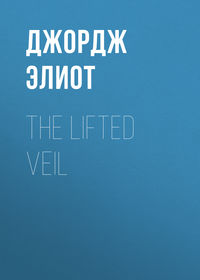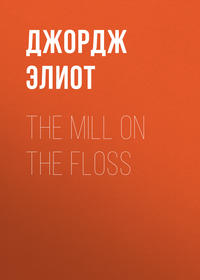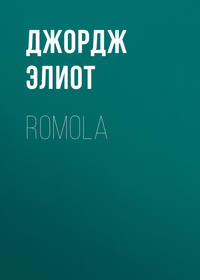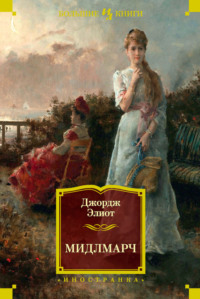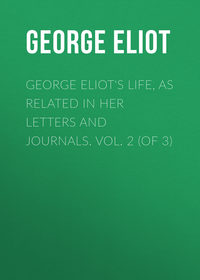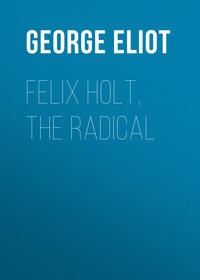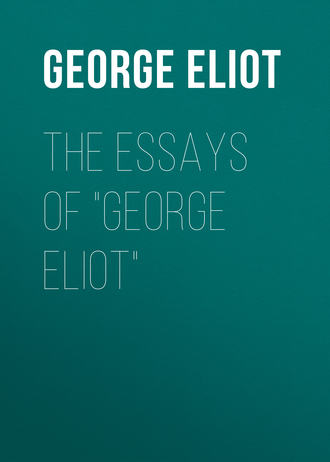 полная версия
полная версияThe Essays of "George Eliot"
As typical a novel of the oracular kind as we can hope to meet with, is “The Enigma: a Leaf from the Chronicles of the Wolchorley House.” The “enigma” which this novel is to solve is certainly one that demands powers no less gigantic than those of a lady novelist, being neither more nor less than the existence of evil. The problem is stated and the answer dimly foreshadowed on the very first page. The spirited young lady, with raven hair, says, “All life is an inextricable confusion;” and the meek young lady, with auburn hair, looks at the picture of the Madonna which she is copying, and – “There seemed the solution of that mighty enigma.” The style of this novel is quite as lofty as its purpose; indeed, some passages on which we have spent much patient study are quite beyond our reach, in spite of the illustrative aid of italics and small caps; and we must await further “development” in order to understand them. Of Ernest, the model young clergyman, who sets every one right on all occasions, we read that “he held not of marriage in the marketable kind, after a social desecration;” that, on one eventful night, “sleep had not visited his divided heart, where tumultuated, in varied type and combination, the aggregate feelings of grief and joy;” and that, “for the marketable human article he had no toleration, be it of what sort, or set for what value it might, whether for worship or class, his upright soul abhorred it, whose ultimatum, the self-deceiver, was to him the great spiritual lie, ‘living in a vain show, deceiving and being deceived;’ since he did not suppose the phylactery and enlarged border on the garment to be merely a social trick.” (The italics and small caps are the author’s, and we hope they assist the reader’s comprehension.) Of Sir Lionel, the model old gentleman, we are told that “the simple ideal of the middle age, apart from its anarchy and decadence, in him most truly seemed to live again, when the ties which knit men together were of heroic cast. The first-born colors of pristine faith and truth engraven on the common soul of man, and blent into the wide arch of brotherhood, where the primæval law of order grew and multiplied each perfect after his kind, and mutually interdependent.” You see clearly, of course, how colors are first engraven on the soul, and then blent into a wide arch, on which arch of colors – apparently a rainbow – the law of order grew and multiplied, each – apparently the arch and the law – perfect after his kind? If, after this, you can possibly want any further aid toward knowing what Sir Lionel was, we can tell you that in his soul “the scientific combinations of thought could educe no fuller harmonies of the good and the true than lay in the primæval pulses which floated as an atmosphere around it!” and that, when he was sealing a letter, “Lo! the responsive throb in that good man’s bosom echoed back in simple truth the honest witness of a heart that condemned him not, as his eye, bedewed with love, rested, too, with something of ancestral pride, on the undimmed motto of the family – ‘Loiaute.’”
The slightest matters have their vulgarity fumigated out of them by the same elevated style. Commonplace people would say that a copy of Shakespeare lay on a drawing-room table; but the authoress of “The Enigma,” bent on edifying periphrasis, tells you that there lay on the table, “that fund of human thought and feeling, which teaches the heart through the little name, ‘Shakespeare.’” A watchman sees a light burning in an upper window rather longer than usual, and thinks that people are foolish to sit up late when they have an opportunity of going to bed; but, lest this fact should seem too low and common, it is presented to us in the following striking and metaphysical manner: “He marvelled – as a man will think for others in a necessarily separate personality, consequently (though disallowing it) in false mental premise – how differently he should act, how gladly he should prize the rest so lightly held of within.” A footman – an ordinary Jeames, with large calves and aspirated vowels – answers the door-bell, and the opportunity is seized to tell you that he was a “type of the large class of pampered menials, who follow the curse of Cain – ‘vagabonds’ on the face of the earth, and whose estimate of the human class varies in the graduated scale of money and expenditure… These, and such as these, O England, be the false lights of thy morbid civilization!” We have heard of various “false lights,” from Dr. Cumming to Robert Owen, from Dr. Pusey to the Spirit-rappers, but we never before heard of the false light that emanates from plush and powder.
In the same way very ordinary events of civilized life are exalted into the most awful crises, and ladies in full skirts and manches à la Chinoise, conduct themselves not unlike the heroines of sanguinary melodramas. Mrs. Percy, a shallow woman of the world, wishes her son Horace to marry the auburn-haired Grace, she being an heiress; but he, after the manner of sons, falls in love with the raven-haired Kate, the heiress’s portionless cousin; and, moreover, Grace herself shows every symptom of perfect indifference to Horace. In such cases sons are often sulky or fiery, mothers are alternately manœuvring and waspish, and the portionless young lady often lies awake at night and cries a good deal. We are getting used to these things now, just as we are used to eclipses of the moon, which no longer set us howling and beating tin kettles. We never heard of a lady in a fashionable “front” behaving like Mrs. Percy under these circumstances. Happening one day to see Horace talking to Grace at a window, without in the least knowing what they are talking about, or having the least reason to believe that Grace, who is mistress of the house and a person of dignity, would accept her son if he were to offer himself, she suddenly rushes up to them and clasps them both, saying, “with a flushed countenance and in an excited manner” – “This is indeed happiness; for, may I not call you so, Grace? – my Grace – my Horace’s Grace! – my dear children!” Her son tells her she is mistaken, and that he is engaged to Kate, whereupon we have the following scene and tableau:
“Gathering herself up to an unprecedented height (!) her eyes lightening forth the fire of her anger:
“‘Wretched boy!’ she said, hoarsely and scornfully, and clenching her hand, ‘Take then the doom of your own choice! Bow down your miserable head and let a mother’s – ’
“‘Curse not!’ spake a deep low voice from behind, and Mrs. Percy started, scared, as though she had seen a heavenly visitant appear, to break upon her in the midst of her sin.
“Meantime Horace had fallen on his knees, at her feet, and hid his, face in his hands.
“Who then, is she – who! Truly his ‘guardian spirit’ hath stepped between him and the fearful words, which, however unmerited, must have hung as a pall over his future existence; – a spell which could not be unbound – which could not be unsaid.
“Of an earthly paleness, but calm with the still, iron-bound calmness of death – the only calm one there – Katherine stood; and her words smote on the ear in tones whose appallingly slow and separate intonation rung on the heart like a chill, isolated tolling of some fatal knell.
“‘He would have plighted me his faith, but I did not accept it; you cannot, therefore – you dare not curse him. And here,’ she continued, raising her hand to heaven, whither her large dark eyes also rose with a chastened glow, which, for the first time, suffering had lighted in those passionate orbs – ‘here I promise, come weal, come woe, that Horace Wolchorley and I do never interchange vows without his mother’s sanction – without his mother’s blessing!’”
Here, and throughout the story, we see that confusion of purpose which is so characteristic of silly novels written by women. It is a story of quite modern drawing-room society – a society in which polkas are played and Puseyism discussed; yet we have characters, and incidents, and traits of manner introduced, which are mere shreds from the most heterogeneous romances. We have a blind Irish harper, “relic of the picturesque bards of yore,” startling us at a Sunday-school festival of tea and cake in an English village; we have a crazy gypsy, in a scarlet cloak, singing snatches of romantic song, and revealing a secret on her death-bed which, with the testimony of a dwarfish miserly merchant, who salutes strangers with a curse and a devilish laugh, goes to prove that Ernest, the model young clergyman, is Kate’s brother; and we have an ultra-virtuous Irish Barney, discovering that a document is forged, by comparing the date of the paper with the date of the alleged signature, although the same document has passed through a court of law and occasioned a fatal decision. The “Hall” in which Sir Lionel lives is the venerable country-seat of an old family, and this, we suppose, sets the imagination of the authoress flying to donjons and battlements, where “lo! the warder blows his horn;” for, as the inhabitants are in their bedrooms on a night certainly within the recollection of Pleaceman X. and a breeze springs up, which we are at first told was faint, and then that it made the old cedars bow their branches to the greensward, she falls into this mediæval vein of description (the italics are ours): “The banner unfurled it at the sound, and shook its guardian wing above, while the startled owl flapped her in the ivy; the firmament looking down through her ‘argus eyes’ —
‘Ministers of heaven’s mute melodies.’
And lo! two strokes tolled from out the warder tower, and ‘Two o’clock’ re-echoed its interpreter below.”
Such stories as this of “The Enigma” remind us of the pictures clever children sometimes draw “out of their own head,” where you will see a modern villa on the right, two knights in helmets fighting in the foreground, and a tiger grinning in a jungle on the left, the several objects being brought together because the artist thinks each pretty, and perhaps still more because he remembers seeing them in other pictures.
But we like the authoress much better on her mediæval stilts than on her oracular ones – when she talks of the Ich and of “subjective” and “objective,” and lays down the exact line of Christian verity, between “right-hand excesses and left-hand declensions.” Persons who deviate from this line are introduced with a patronizing air of charity. Of a certain Miss Inshquine she informs us, with all the lucidity of italics and small caps, that “function, not form, as the inevitable outer expression of the spirit in this tabernacle age, weakly engrossed her.” And à propos of Miss Mayjar, an evangelical lady who is a little too apt to talk of her visits to sick women and the state of their souls, we are told that the model clergyman is “not one to disallow, through the super crust, the undercurrent toward good in the subject, or the positive benefits, nevertheless, to the object.” We imagine the double-refined accent and protrusion of chin which are feebly represented by the italics in this lady’s sentences! We abstain from quoting any of her oracular doctrinal passages, because they refer to matters too serious for our pages just now.
The epithet “silly” may seem impertinent, applied to a novel which indicates so much reading and intellectual activity as “The Enigma,” but we use this epithet advisedly. If, as the world has long agreed, a very great amount of instruction will not make a wise man, still less will a very mediocre amount of instruction make a wise woman. And the most mischievous form of feminine silliness is the literary form, because it tends to confirm the popular prejudice against the more solid education of women.
When men see girls wasting their time in consultations about bonnets and ball dresses, and in giggling or sentimental love-confidences, or middle-aged women mismanaging their children, and solacing themselves with acrid gossip, they can hardly help saying, “For Heaven’s sake, let girls be better educated; let them have some better objects of thought – some more solid occupations.” But after a few hours’ conversation with an oracular literary woman, or a few hours’ reading of her books, they are likely enough to say, “After all, when a woman gets some knowledge, see what use she makes of it! Her knowledge remains acquisition instead of passing into culture; instead of being subdued into modesty and simplicity by a larger acquaintance with thought and fact, she has a feverish consciousness of her attainments; she keeps a sort of mental pocket-mirror, and is continually looking in it at her own ‘intellectuality;’ she spoils the taste of one’s muffin by questions of metaphysics; ‘puts down’ men at a dinner-table with her superior information; and seizes the opportunity of a soirée to catechise us on the vital question of the relation between mind and matter. And then, look at her writings! She mistakes vagueness for depth, bombast for eloquence, and affectation for originality; she struts on one page, rolls her eyes on another, grimaces in a third, and is hysterical in a fourth. She may have read many writings of great men, and a few writings of great women; but she is as unable to discern the difference between her own style and theirs as a Yorkshireman is to discern the difference between his own English and a Londoner’s: rhodomontade is the native accent of her intellect. No – the average nature of women is too shallow and feeble a soil to bear much tillage; it is only fit for the very lightest crops.”
It is true that the men who come to such a decision on such very superficial and imperfect observation may not be among the wisest in the world; but we have not now to contest their opinion – we are only pointing out how it is unconsciously encouraged by many women who have volunteered themselves as representatives of the feminine intellect. We do not believe that a man was ever strengthened in such an opinion by associating with a woman of true culture, whose mind had absorbed her knowledge instead of being absorbed by it. A really cultured woman, like a really cultured man, is all the simpler and the less obtrusive for her knowledge; it has made her see herself and her opinions in something like just proportions; she does not make it a pedestal from which she flatters herself that she commands a complete view of men and things, but makes it a point of observation from which to form a right estimate of herself. She neither spouts poetry nor quotes Cicero on slight provocation; not because she thinks that a sacrifice must be made to the prejudices of men, but because that mode of exhibiting her memory and Latinity does not present itself to her as edifying or graceful. She does not write books to confound philosophers, perhaps because she is able to write books that delight them. In conversation she is the least formidable of women, because she understands you, without wanting to make you aware that you can’t understand her. She does not give you information, which is the raw material of culture – she gives you sympathy, which is its subtlest essence.
A more numerous class of silly novels than the oracular (which are generally inspired by some form of High Church or transcendental Christianity) is what we may call the white neck-cloth species, which represent the tone of thought and feeling in the Evangelical party. This species is a kind of genteel tract on a large scale, intended as a sort of medicinal sweetmeat for Low Church young ladies; an Evangelical substitute for the fashionable novel, as the May Meetings are a substitute for the Opera. Even Quaker children, one would think, can hardly have been denied the indulgence of a doll; but it must be a doll dressed in a drab gown and a coal-scuttle-bonnet – not a worldly doll, in gauze and spangles. And there are no young ladies, we imagine – unless they belong to the Church of the United Brethren, in which people are married without any love-making – who can dispense with love stories. Thus, for Evangelical young ladies there are Evangelical love stories, in which the vicissitudes of the tender passion are sanctified by saving views of Regeneration and the Atonement. These novels differ from the oracular ones, as a Low Churchwoman often differs from a High Churchwoman: they are a little less supercilious and a great deal more ignorant, a little less correct in their syntax and a great deal more vulgar.
The Orlando of Evangelical literature is the young curate, looked at from the point of view of the middle class, where cambric bands are understood to have as thrilling an effect on the hearts of young ladies as epaulettes have in the classes above and below it. In the ordinary type of these novels the hero is almost sure to be a young curate, frowned upon, perhaps by worldly mammas, but carrying captive the hearts of their daughters, who can “never forget that sermon;” tender glances are seized from the pulpit stairs instead of the opera-box; tête-à-têtes are seasoned with quotations from Scripture instead of quotations from the poets; and questions as to the state of the heroine’s affections are mingled with anxieties as to the state of her soul. The young curate always has a background of well-dressed and wealthy if not fashionable society – for Evangelical silliness is as snobbish as any other kind of silliness – and the Evangelical lady novelist, while she explains to you the type of the scapegoat on one page, is ambitious on another to represent the manners and conversations of aristocratic people. Her pictures of fashionable society are often curious studies, considered as efforts of the Evangelical imagination; but in one particular the novels of the White Neck-cloth School are meritoriously realistic – their favorite hero, the Evangelical young curate, is always rather an insipid personage.
The most recent novel of this species that we happen to have before us is “The Old Grey Church.” It is utterly tame and feeble; there is no one set of objects on which the writer seems to have a stronger grasp than on any other; and we should be entirely at a loss to conjecture among what phases of life her experience has been gained, but for certain vulgarisms of style which sufficiently indicate that she has had the advantage, though she has been unable to use it, of mingling chiefly with men and women whose manners and characters have not had all their bosses and angles rubbed down by refined conventionalism. It is less excusable in an Evangelical novelist than in any other, gratuitously to seek her subjects among titles and carriages. The real drama of Evangelicalism – and it has abundance of fine drama for any one who has genius enough to discern and reproduce it – lies among the middle and lower classes; and are not Evangelical opinions understood to give an especial interest in the weak things of the earth, rather than in the mighty? Why, then, cannot our Evangelical lady novelists show us the operation of their religious views among people (there really are many such in the world) who keep no carriage, “not so much as a brass-bound gig,” who even manage to eat their dinner without a silver fork, and in whose mouths the authoress’s questionable English would be strictly consistent? Why can we not have pictures of religious life among the industrial classes in England, as interesting as Mrs. Stowe’s pictures of religious life among the negroes? Instead of this pious ladies nauseate us with novels which remind us of what we sometimes see in a worldly woman recently “converted;” – she is as fond of a fine dinner-table as before, but she invites clergymen instead of beaux; she thinks as much of her dress as before, but she adopts a more sober choice of colors and patterns; her conversation is as trivial as before, but the triviality is flavored with gospel instead of gossip. In “The Old Grey Church” we have the same sort of Evangelical travesty of the fashionable novel, and of course the vicious, intriguing baronet is not wanting. It is worth while to give a sample of the style of conversation attributed to this high-born rake – a style that, in its profuse italics and palpable innuendoes, is worthy of Miss Squeers. In an evening visit to the ruins of the Colosseum, Eustace, the young clergyman, has been withdrawing the heroine, Miss Lushington, from the rest of the party, for the sake of a tête-à-tête. The baronet is jealous, and vents his pique in this way:
“There they are, and Miss Lushington, no doubt, quite safe; for she is under the holy guidance of Pope Eustace the First, who has, of course, been delivering to her an edifying homily on the wickedness of the heathens of yore, who, as tradition tells us, in this very place let loose the wild beastises on poor St. Paul! – Oh, no! by the bye, I believe I am wrong, and betraying my want of clergy, and that it was not at all St. Paul, nor was it here. But no matter, it would equally serve as a text to preach from, and from which to diverge to the degenerate heathen Christians of the present day, and all their naughty practices, and so end with an exhortation to ‘come but from among them, and be separate;’ – and I am sure, Miss Lushington, you have most scrupulously conformed to that injunction this evening, for we have seen nothing of you since our arrival. But every one seems agreed it has been a charming party of pleasure, and I am sure we all feel much indebted to Mr. Gray for having suggested it; and as he seems so capital a cicerone, I hope he will think of something else equally agreeable to all.”
This drivelling kind of dialogue, and equally drivelling narrative, which, like a bad drawing, represents nothing, and barely indicates what is meant to be represented, runs through the book; and we have no doubt is considered by the amiable authoress to constitute an improving novel, which Christian mothers will do well to put into the hands of their daughters. But everything is relative; we have met with American vegetarians whose normal diet was dry meal, and who, when their appetite wanted stimulating, tickled it with wet meal; and so, we can imagine that there are Evangelical circles in which “The Old Grey Church” is devoured as a powerful and interesting fiction.
But perhaps the least readable of silly women’s novels are the modern-antique species, which unfold to us the domestic life of Jannes and Jambres, the private love affairs of Sennacherib, or the mental struggles and ultimate conversion of Demetrius the silversmith. From most silly novels we can at least extract a laugh; but those of the modern-antique school have a ponderous, a leaden kind of fatuity, under which we groan. What can be more demonstrative of the inability of literary women to measure their own powers than their frequent assumption of a task which can only be justified by the rarest concurrence of acquirement with genius? The finest effort to reanimate the past is of course only approximative – is always more or less an infusion of the modern spirit into the ancient form —
Was ihr den Geist der Zeiten heisst,Das ist im Grund der Herren eigner Geist,In dem die Zeiten sich bespiegeln.Admitting that genius which has familiarized itself with all the relics of an ancient period can sometimes, by the force of its sympathetic divination, restore the missing notes in the “music of humanity,” and reconstruct the fragments into a whole which will really bring the remote past nearer to us, and interpret it to our duller apprehension – this form of imaginative power must always be among the very rarest, because it demands as much accurate and minute knowledge as creative vigor. Yet we find ladies constantly choosing to make their mental mediocrity more conspicuous by clothing it in a masquerade of ancient names; by putting their feeble sentimentality into the mouths of Roman vestals or Egyptian princesses, and attributing their rhetorical arguments to Jewish high-priests and Greek philosophers. A recent example of this heavy imbecility is “Adonijah, a Tale of the Jewish Dispersion,” which forms part of a series, “uniting,” we are told, “taste, humor, and sound principles.” “Adonijah,” we presume, exemplifies the tale of “sound principles;” the taste and humor are to be found in other members of the series. We are told on the cover that the incidents of this tale are “fraught with unusual interest,” and the preface winds up thus: “To those who feel interested in the dispersed of Israel and Judea, these pages may afford, perhaps, information on an important subject, as well as amusement.” Since the “important subject” on which this book is to afford information is not specified, it may possibly lie in some esoteric meaning to which we have no key; but if it has relation to the dispersed of Israel and Judea at any period of their history, we believe a tolerably well-informed school-girl already knows much more of it than she will find in this “Tale of the Jewish Dispersion.” “Adonijah” is simply the feeblest kind of love story, supposed to be instructive, we presume, because the hero is a Jewish captive and the heroine a Roman vestal; because they and their friends are converted to Christianity after the shortest and easiest method approved by the “Society for Promoting the Conversion of the Jews;” and because, instead of being written in plain language, it is adorned with that peculiar style of grandiloquence which is held by some lady novelists to give an antique coloring, and which we recognize at once in such phrases as these: – “the splendid regnal talent, undoubtedly, possessed by the Emperor Nero” – “the expiring scion of a lofty stem” – “the virtuous partner of his couch” – “ah, by Vesta!” – and “I tell thee, Roman.” Among the quotations which serve at once for instruction and ornament on the cover of this volume, there is one from Miss Sinclair, which informs us that “Works of imagination are avowedly read by men of science, wisdom, and piety;” from which we suppose the reader is to gather the cheering inference that Dr. Daubeny, Mr. Mill, or Mr. Maurice may openly indulge himself with the perusal of “Adonijah,” without being obliged to secrete it among the sofa cushions, or read it by snatches under the dinner-table.



